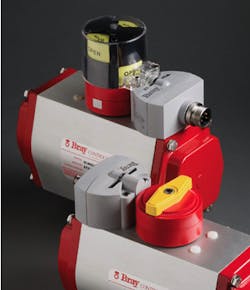Compact Valve Status Monitors with DC, AC, or Bus Network Signaling
The Series 52 now includes AS-i, DeviceNet™ and PROFIBUS® DP BUS network units with a solenoid drive, plus new features have been added to the entire line. Bray’s 2N1 ProxSensors uniquely combine two proximity sensors in one compact, self-contained and fully sealed enclosure. These valve status monitors deliver the rapid, bounce-free electronic valve signaling required for PLC, computer and solid-state circuitry used in process control and information networks. All units have a unique 5-year warranty against material or workmanship defects. In addition to the factory pre-aligned Standard Targets, Bray now offers Adjustable Targets. These allow the customer to individually set both valve position signals at incremental angles before or on the fully open and fully closed positions. DC and AC targets are stainless steel and nonmagnetic. These targets will not attract and be falsely tripped by loose metal objects. Magnetic targets are used in BUS network units. The local LED Indicators on many units were increased to not only verify that the sensors are electrically functioning and that the target position has been reached, but also to indicate power/network status. Another added feature is an optional Valve Position Display. Double the height of the standard position pointer, the high visibility display is prominently labeled and color coded: yellow for open, black for closed. Both position indicators locally indicate valve position throughout the full range of travel. Bray’s new BUS Intelligent 2N1 ProxSensors offer all the features of the DC and AC units, plus network protocol/communication and remote access to valve position and diagnostics. These intelligent units contain two BUS powered proximity sensors and applicable network pin and solenoid drive connections. Bray’s 2N1 ProxSensor AC, PNP or NPN DC and NAMUR Intrinsically Safe DC units have two inductive proximity sensors. No switching amplifier is needed for the AC units. The DC units have an economical internal amplifier. The NAMUR Intrinsically Safe DC sensor is for use with an IS barrier amplifier. BUS unit sensors and the solenoid drive are powered by the network. The Series 52 is engineered to be impervious to vibration, moisture and most chemical and corrosive agents since all internal components are completely encapsulated with epoxy resin inside the rigid, fully-sealed polymer enclosure. Multi-pin electrical connectors are weatherproof and provide quick-connect installation. Standardized factory pre-wiring prevents field wiring errors. The 2N1 ProxSensor mounts directly to Bray pneumatic actuators, eliminating contamination buildup between sensor and actuator. Bray International, Inc., headquartered in Houston, Texas, is a leader and innovator in process control automation, with worldwide manufacturing and distribution facilities. Products include automated and manual 1" through 96" (25 mm - 2400 mm) butterfly valves, pneumatic and electric actuators, valve status monitors, electro-pneumatic and pneumatic positioners, solenoid valves and control accessories. For more information, visit www.bray.com.

